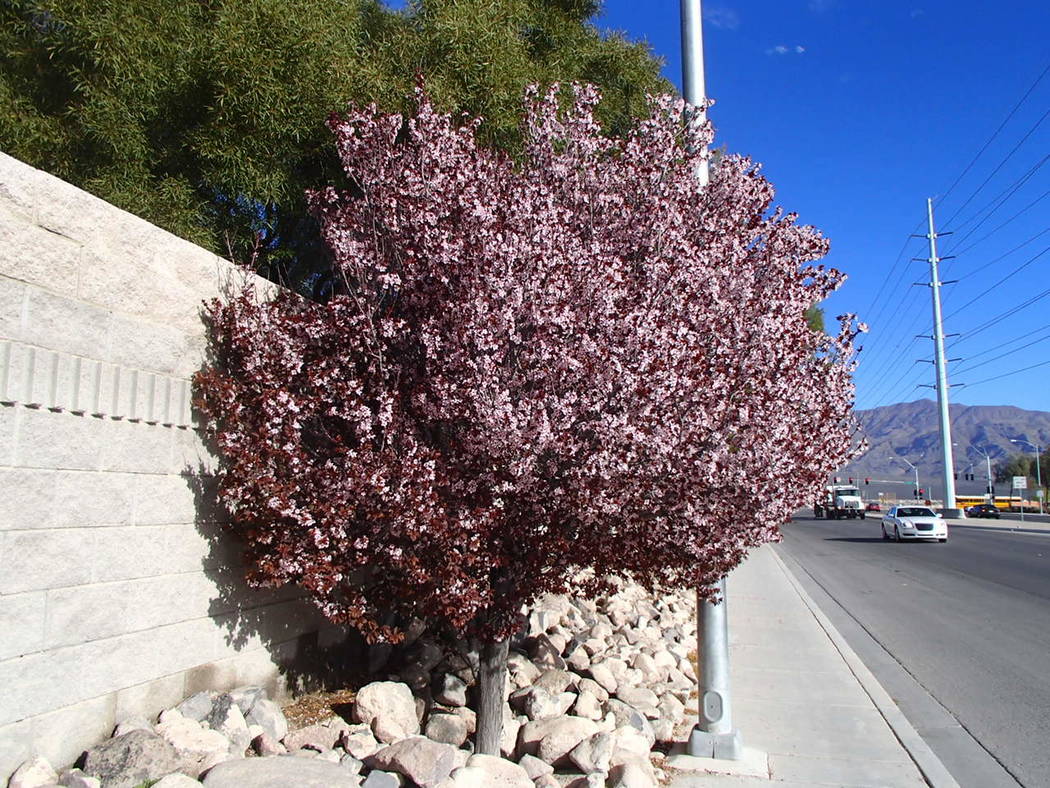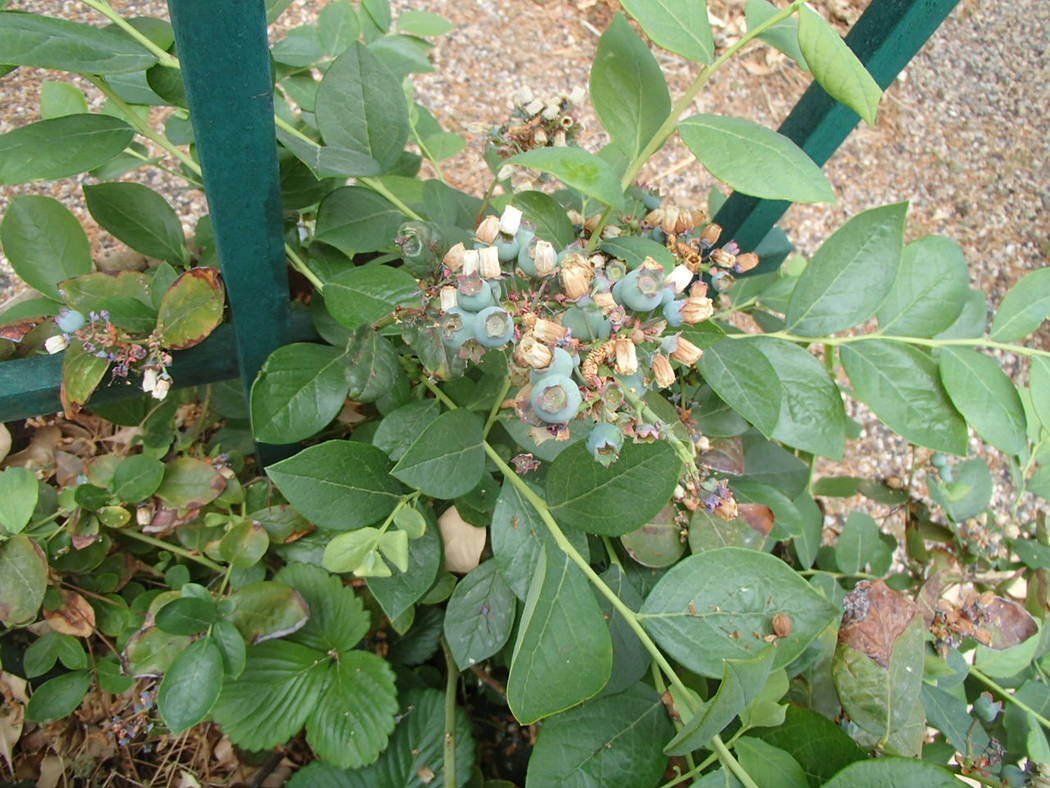Ornamental pear, flowering plum in full bloom
Q: My husband and I just moved to Summerlin, and I am seeing pink and white blooms on trees in this area. Do you know what kind of trees these are?
A: Two very popular ornamental trees grown in our desert climate are the ornamental pear and flowering plum. Both bloom this time of year. Very popular and commonly planted, they are tough survivors in urban landscapes and adapt to our desert environment. They are not desert species but can handle our summer temperatures and low humidity.
The ornamental pear has very showy white flowers in the spring that last two to three weeks depending on temperatures. Sometimes called Callery pear, the oldest variety is Bradford but has been replaced by other improved varieties.
The flowering plum, in addition to very showy pink- and rose-colored flowers, frequently produces fruit. Several varieties of flowering plum exist: some with green leaves, some with purple leaves and some with purple leaves that turn green as they mature.
I frequently get questions whether the fruit is edible or not. Yes, it is. A number of people collect this fruit and make excellent jams or jellies and alcoholic beverages from it.
If you’re thinking of planting these trees, they will grow best with the soil above their roots covered in wood chips that easily decompose, enriching the soil. They struggle in soils covered with rock and frequently develop problems.
Although they grow in the desert environments, they are not desert plants. Water and fertilize them like a fruit tree. But prune them as an ornamental tree.
Plant them as you would any other landscape tree or shrub. Dig the hole at least three times the diameter of the container. Mix a good quality compost and a couple handfuls of phosphorus fertilizer into the soil removed from the hole — about 50 percent by volume.
When planting these trees, remove them from the container and use plenty of water during planting. The planting hole should be a slurry of soil, compost and fertilizer when finished to remove air pockets and then allowed to drain.
Make a basin around the tree 3 to 4 inches deep and fill it with water three times after planting. Continue hand watering these trees three times a week, filling the basin each time, before leaving them to your irrigation system.
If the tree has a stake in the container, cut the green plastic fastening the tree to the stake and pound it solidly into the soil at the bottom of the hole. Reattach the stake to the tree with green nursery tape to prevent the roots from moving. Remove the stake after the first growing season.
Q: Can established lemon trees in a large pot co-exist with apple seedlings while the seedlings grow larger?
A: I assume you want to use the existing soil in this container to grow apple seedlings alongside an established lemon tree. Perhaps you want to use the shade from the lemon tree to give the apple seedlings some protection from the sun or trying to save space.
Let’s cover first things first. The best time of year to grow apples from seed is in the fall, germinating them directly in the soil around mid-September to mid-October. All apple seedlings that grow in our climate will sail through our winters just fine.
You also can grow apples from seed in the spring. When you plant apple seeds in the fall, they have growth from two “springs” to get some size. When planting seeds in the spring, they have only one “spring” to get big. Seedlings grown in the spring will not develop the same size as they would if planted in the fall.
Yes, they will do just fine planted in a container alongside established lemon trees. These two trees — apple and lemon — will not “fight” with each other.
You will have a problem growing them from seed if the lemon tree is quite a bit older. The roots of older trees growing in containers might not provide enough room for new seedlings to get established. The roots of an older, established lemon tree might choke out apple seedlings.
I am curious why would you want to do this. Apples grown from seed produce fruit quality somewhere in between the fruit quality of the two parent trees. The fruit might be good or it might not. It’s a four- to five-year crap shoot.
Secondly, this tree will be on its own roots and full-sized. Nearly all of the apples available now are dwarf or semi-dwarf. This is because they are grafted to keep them smaller and producing fruit earlier.
Unless you are doing this out of curiosity, or as a hobby, it is not worth your time and effort. Buy a known apple tree variety that you like on a dwarfing rootstock. You will be happier.
Q: I planted three blueberry plants (Southmoon and Misty) last year, and they haven’t grown. I used compost and peat moss in a raised bed and added soil acidifier. They are growing very little, and the new growth is reddish. I suspect the problem is nutritional, but I need advice.
A: Please realize that blueberries are “iffy” in our climate and soils. One of my precautions to people: When plants are less suitable to our climate and soils, the more time, energy and money is required to keep them growing and in good health. I agree with you; it is probably a soil nutritional problem. But it can be remedied.
That being said, I have seen blueberries productive here. Very close attention must be paid to the variety and type of blueberry selected, planting location, amendments added to the soil at planting and every year thereafter, and irrigation.
You picked blueberry varieties that work well here. We must use Southern, highbush blueberries in our climate. Southmoon and Misty are appropriate, as well as some others such as O’Neil, Sharpblue and Sunshine Blue.
Blueberries do not like our climate very much and perform better when protected from late afternoon sun. But they need six to eight hours of full sunlight for good fruit production. Eastern exposures or full sun with protection from direct sunlight during mid to late afternoons is best.
Plenty of compost should be mixed into the soil at the time of planting. Either use a good quality compost and mix it into your existing soil at a 50/50 ratio or use a good quality planting mix in the raised bed.
Soils are where you must be careful. Compost and soil mixes are not all the same in quality. When using poor quality compost or soil mixes, these plants will fail. Guaranteed.
Soil acidifiers help, but use the right kind of soil acidifier. Granular sulfur does not work. It does very little to increase soil acidity. Sulfur, yes, but granular, no. A better choice is water-dispersible (powdered) sulfur. If the soil is warm and moist, powdered or water-dispersible sulfur adds acidity to the soil which blueberries need.
There are other products that add acidity to the soil. Contact me through email or my blog if you need to find them.
Blueberries do quite well if fertilized with good quality compost in January or February, once a year. If the soil is good quality, well-balanced mineral fertilizers used for roses or tomatoes work OK. Whenever possible, select acidifying or acid-forming fertilizers intended for flowering and fruit producing plants. It will state this on the label.
Cover the surface of the soil in a layer of wood chips 3 to 4 inches deep. Wood chips from trees taken out of urban landscapes work well. Keep this surface mulch 6 inches from the plants, but cover the soil where roots are growing.
Water them as you would fruit trees and other nondesert landscape plants. Keep the soil moist but not wet. Use a water moisture meter for houseplants if you are unsure when to water. Make sure that 20 percent of the applied water drains away from the roots.
Bob Morris is a horticulture expert living in Las Vegas and professor emeritus for the University of Nevada. Visit his blog at xtremehorticulture.blogspot.com. Send questions to Extremehort@aol.com.


















